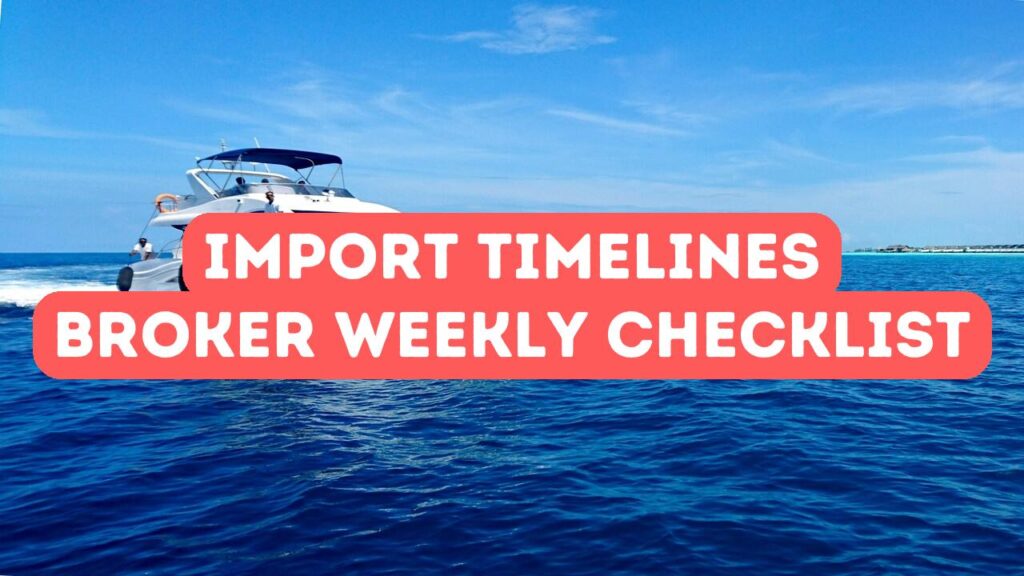Importing goods successfully isn’t just about watching containers move across the ocean. It’s a finely tuned dance involving the complex world of import timelines, where even minor missteps can lead to costly delays. A broker’s week-by-week checklist is a life’s work of lessons learned and experience garnered, ensuring that every shipment reaches its destination smoothly. The customs process doesn’t tolerate hesitation. To navigate it well, one must diligently follow this roadmap, considering every detail. Understanding import regulations might feel like learning a new language, but it’s crucial for ensuring compliance. Every change in the shipping schedule can ripple through your plans—keep a sharp eye. Picture it like a well-rehearsed play, where timing ensures everything goes off without a hitch. So, when it comes to preparing for the import journey, trust in your week-by-week guide. It’s the compass that can steer you through even the stormiest seas of shipping logistics.
Navigating Import Timelines: Essential Steps for Brokers
Understanding import timelines is pivotal for brokers, transforming chaos into orderly flow. The journey begins with assembling a broker checklist designed to streamline actions. This list becomes your trusty guideline, encompassing every critical step. First and foremost, initiate the customs process early. This head start reduces unforeseen issues and prevents last-minute hiccups. Next, stay well-versed in import regulations to ensure all boxes ticked align with legal requirements. Neglecting this is akin to setting off a chain of dominoes, leading to possible halts or penalties. Stay adaptable with your shipping schedule; timing can be unpredictable. External factors might alter your plans, but with vigilance and preparation, you navigate these waters adeptly. Embrace the rhythm of import timelines as it shapes the backdrop of global trade, ensuring you dance confidently through the logistics world.
Navigating the import timelines means more than just sticking to a schedule. Start by diving into the broker checklist, which acts as your reliable compass. Each tick on the list represents a crucial step in the customs process—a journey in itself. Understanding import regulations shouldn’t be an afterthought; it’s as essential as a ship’s rudder. Without it, you’re adrift in a sea of paperwork. As you move forward, adjust your shipping schedule with the precision of a maestro orchestrating a symphony. After all, one small delay can crescendo into a major setback. Stay connected with all parties involved—communication is your lifeline. Make sure every link in the chain is strong enough to handle the voyage. With every step measured and calculated, trust in your expertise. This is the path brokers tread—a tapestry woven with experience, ensuring every shipment’s seamless journey.
Navigating import timelines successfully requires a broker to leverage essential strategies. Begin by establishing a proactive mindset—anticipate potential obstacles before they arise. This foresight, combined with a well-prepared broker checklist, ensures every shipment glides through the customs process smoothly. Understanding import regulations unlocks the gates to a hassle-free experience, minimizing the risk of unexpected disruptions. Remember, a flexible shipping schedule is as crucial as any import plan. Imagine it as a dance, adapting to the melody of changing circumstances. Keep the communication channels open, ensuring seamless coordination among all parties involved. This collaboration, a testament to your expertise, transforms a complex maze into a clear path. Each decision made with precision contributes to a robust import timeline strategy, allowing brokers to turn potential chaos into flawless execution. Trust in this methodical approach as it steadies the ship through the tides of international logistics.
Maximizing Efficiency: A Week-by-Week Breakdown for Successful Imports
Maximizing efficiency within import timelines hinges on careful planning and precise execution. The broker checklist serves as your playbook for navigating this journey, with each week introducing a new set of tasks. In the first week, lay the groundwork for a seamless customs process. Confirm that all import regulations are up to date, ensuring your documentation reflects any recent changes. Start drafting a shipping schedule that caters to your unique needs, paying attention to international holidays and potential port delays. Like a chess game, one wrong move can cascade into larger issues. Confirm your suppliers are aware of their deadlines, emphasizing the need for punctuality. Think of this initial stage as planting the seeds for a successful harvest—each carefully placed to guarantee a bountiful yield. With these strategic steps, you set the pace for the weeks to follow, aligning your actions with a harmonious tempo in the realm of imports.
By the second week, dive deeper into the labyrinth of the customs process. Your broker checklist should now focus on collaborating with customs officials to preempt any hurdles. Clarify import regulations to prevent potential pit stops. Evaluate shipping schedules meticulously, identifying if any revisions are needed to accommodate unexpected variables. Picture this as adjusting sails mid-voyage to harness every wind. Ensure your documentation is pristine, a mirror of compliance to the best practices. Open a dialogue with your freight partners about impending deadlines, enabling a seamless coordination like a maestro leading an orchestra. The synergy between all stakeholders is key here, yielding a rhythm that’s both precise and flexible. Each orchestrated move within the import timelines prevents snafus that could derail your cargo’s journey. Channel the expertise seasoned by experience, ensuring everything you touch adheres to the highest standards of efficiency. Your commitment now lays the strategic groundwork for the days ahead.
As you turn the page into the third week, your import timelines should find their stride, settling into a rhythm akin to a seasoned conductor guiding a symphony. This is when the broker checklist sharpens its focus on integrating all moving parts. Refine your shipping schedule based on insights gathered thus far, accommodating any fluctuations with deft precision. Dive further into the customs process, ensuring all import regulations are continuously met with diligence. This dance requires constant communication; reach out to suppliers and logistics partners, confirming that all milestones are clearly understood and on track. Think of these interactions like fine-tuning an instrument, ensuring harmony throughout. Cultivate relationships with customs officials, as their cooperation often serves as the linchpin in avoiding unforeseen delays. This week is about orchestrating each element to keep the supply chain running seamlessly—executing each task with grace and ensuring your import journey sails forward without a hitch.
Common Pitfalls in Import Timelines: How to Avoid Delays and Ensure Smooth Transactions
Navigating import timelines can feel like walking a tightrope, with common pitfalls lurking at every step. Missed deadlines, incomplete paperwork, and unforeseen custom process hiccups can transform smooth operations into chaotic messes. These hiccups often stem from misjudging import regulations or neglecting to update the shipping schedule with precision. To shield against such disruptions, a broker’s checklist becomes indispensable—a vigilant guardian ensuring each box is ticked with care. Think of it as your trusty guide, illuminating every twist and turn to keep shipments on track. By adhering to this roadmap, you sidestep missteps, ensuring your timelines remain unblemished and your transactions seamless. It’s a chess game, where foresight and strategy outshine reactive maneuvers. So, sharpen your focus and keep your boots strapped for this journey, armed with the knowledge that it’s not just about reaching the destination, but navigating there flawlessly.
Staying ahead of common pitfalls in import timelines requires vigilance and discipline. Unforeseen delays often sprout from minor oversights—like underestimating the intricacies of the customs process or misaligning with import regulations. These can snowball, derailing your shipping schedule and causing sleepless nights for anyone involved. To mitigate this, your broker checklist is your lifeline. It’s your watchful companion in this high-stakes game. Constantly review and update it. Have eagle-eyed precision; any neglected detail could cost time and money. The real art lies in preemptive planning. Monitor each phase carefully and don’t just react. Be proactive. Engage with authorities to stay updated on import regulations. Time is your rival, but also your ally if you manage it well. Swift communication with partners ensures you’re always in the know, creating a seamless tapestry of operations where every thread is meticulously woven to avert interruptions.
Meeting deadlines in import timelines demands more than just checking boxes; it’s about foresight and precision. Weather changes, labor strikes, or errors in the customs process are not just possible—they’re probable. Laying out a broker checklist can protect you from these curveballs. Think of it as your safety net, always there, ensuring your journey through import regulations is as smooth as stepping stones across a river. Identify bottlenecks early, fortify your shipping schedule with allowances for buffer time, and maintain relentless attention to detail. Line up your documentation like soldiers ready for inspection, and keep communication lines open like lifelines over troubled waters. Remember, your broker checklist is not just paper; it’s your safeguard against chaos. Always adapt, learn, and remain vigilant. Prepare as if you’re about to play a high-stakes game of chess, and you’ll transform potential pitfalls into polished, seamless transactions.
Disclaimer: This article is for general informational purposes only and you are strongly advised to consult a professional to evaluate your personal situation. No liability is accepted that may arise from the use of the information in this article.






